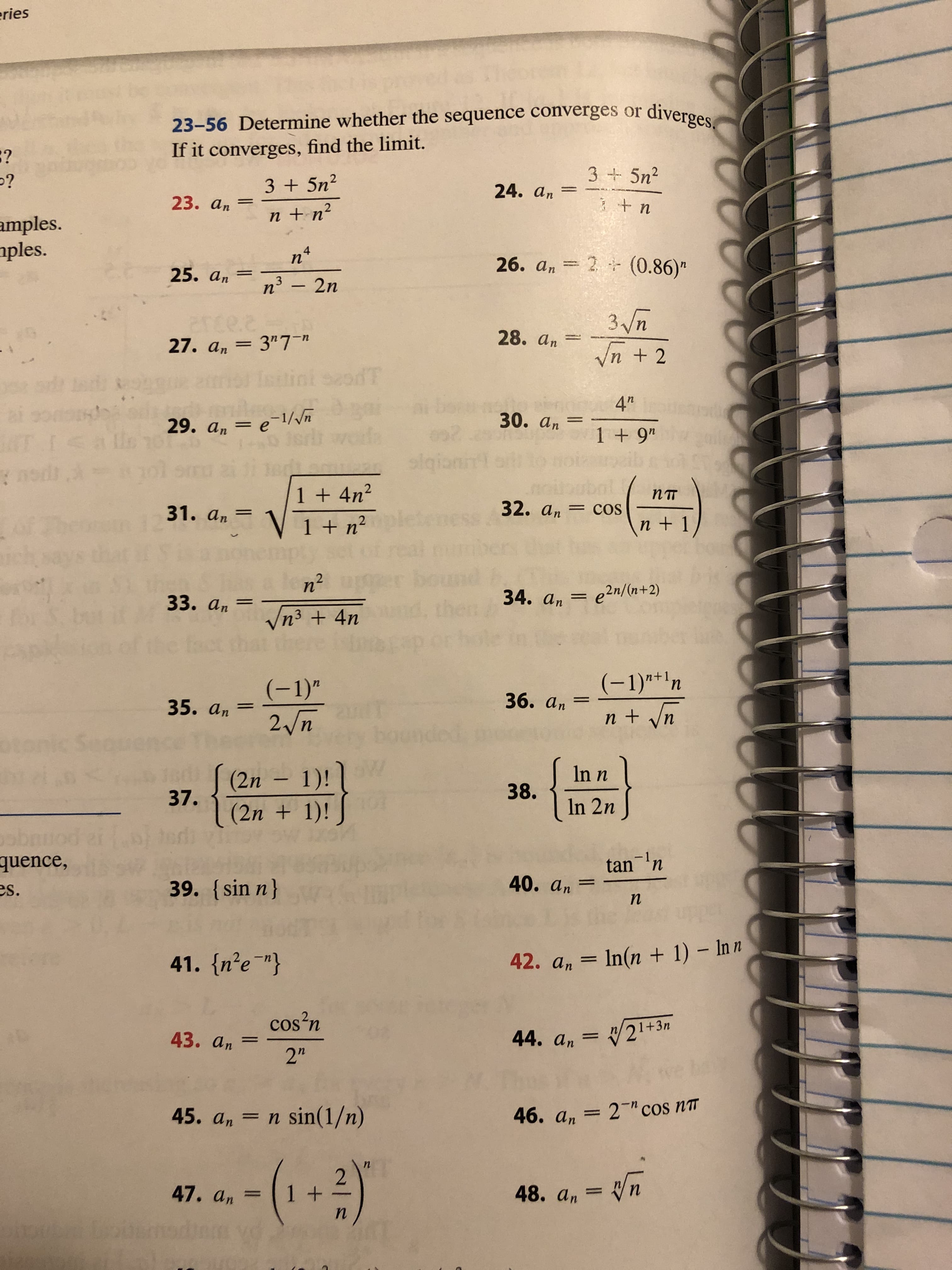ries diverges 23-56 Determine whether the sequence converges or If it converges, find the limit. :? ? 3 +5n2 3 5n2 24. an 23. аn +n nn2 amples. ples. n4 26. an 2(0.86)" 25. an n3 2n 3n Vn2 2ce.e 27. an 3"7 28. an tini sodT 4" 30. аn 29. а, — е 1/ 1 + 9" 4 IS tnodr sai 1 + 4n2 пт 32. an=cos 31. а, V me n + 1 1 + n2 bound n2 n3 4n e2n/(a+2) 34. an e2n/(n+2) 3. аn (-1)"1n (-1)" 36. аn 35. аn n + n 2 n boondo oto Seo SW (2n 1) 10t (2n 1)! { In n 38. 37. In 2n quence, tan n 40. аn 39. sin n} es. п In(n +1)- In n 41. {n'e"} 42. an cos'n V21+3m 44. an 43. аn 2 b 2 " cos nT 45. а, = n sin(1/n) 46. an - () n 2 1 + 47. an 48. аn n
ries diverges 23-56 Determine whether the sequence converges or If it converges, find the limit. :? ? 3 +5n2 3 5n2 24. an 23. аn +n nn2 amples. ples. n4 26. an 2(0.86)" 25. an n3 2n 3n Vn2 2ce.e 27. an 3"7 28. an tini sodT 4" 30. аn 29. а, — е 1/ 1 + 9" 4 IS tnodr sai 1 + 4n2 пт 32. an=cos 31. а, V me n + 1 1 + n2 bound n2 n3 4n e2n/(a+2) 34. an e2n/(n+2) 3. аn (-1)"1n (-1)" 36. аn 35. аn n + n 2 n boondo oto Seo SW (2n 1) 10t (2n 1)! { In n 38. 37. In 2n quence, tan n 40. аn 39. sin n} es. п In(n +1)- In n 41. {n'e"} 42. an cos'n V21+3m 44. an 43. аn 2 b 2 " cos nT 45. а, = n sin(1/n) 46. an - () n 2 1 + 47. an 48. аn n
Algebra & Trigonometry with Analytic Geometry
13th Edition
ISBN:9781133382119
Author:Swokowski
Publisher:Swokowski
Chapter10: Sequences, Series, And Probability
Section10.3: Geometric Sequences
Problem 1E
Related questions
Topic Video
Question
Determine whether the sequence converges or diverges. If it converges, find the limit.
46. a sub n = (2^-n)cos n pi

Transcribed Image Text:ries
diverges
23-56 Determine whether the sequence converges or
If it converges, find the limit.
:?
?
3 +5n2
3 5n2
24. an
23. аn
+n
nn2
amples.
ples.
n4
26. an 2(0.86)"
25. an
n3 2n
3n
Vn2
2ce.e
27. an 3"7
28. an
tini sodT
4"
30. аn
29. а, — е 1/
1 + 9"
4 IS
tnodr
sai
1 + 4n2
пт
32. an=cos
31. а,
V
me
n + 1
1 + n2
bound
n2
n3 4n
e2n/(a+2)
34. an e2n/(n+2)
3. аn
(-1)"1n
(-1)"
36. аn
35. аn
n + n
2 n
boondo
oto
Seo
SW
(2n 1)
10t
(2n 1)!
{
In n
38.
37.
In 2n
quence,
tan n
40. аn
39. sin n}
es.
п
In(n +1)- In n
41. {n'e"}
42. an
cos'n
V21+3m
44. an
43. аn
2
b
2 " cos nT
45. а,
= n sin(1/n)
46. an
- ()
n
2
1 +
47. an
48. аn
n
Expert Solution
This question has been solved!
Explore an expertly crafted, step-by-step solution for a thorough understanding of key concepts.
This is a popular solution!
Trending now
This is a popular solution!
Step by step
Solved in 3 steps with 4 images

Knowledge Booster
Learn more about
Need a deep-dive on the concept behind this application? Look no further. Learn more about this topic, calculus and related others by exploring similar questions and additional content below.Recommended textbooks for you

Algebra & Trigonometry with Analytic Geometry
Algebra
ISBN:
9781133382119
Author:
Swokowski
Publisher:
Cengage


Algebra & Trigonometry with Analytic Geometry
Algebra
ISBN:
9781133382119
Author:
Swokowski
Publisher:
Cengage
